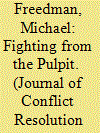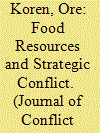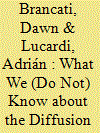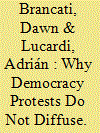|
|
|
Sort Order |
|
|
|
Items / Page
|
|
|
|
|
|
|
| Srl | Item |
| 1 |
ID:
170194


|
|
|
|
|
| Summary/Abstract |
Religious leaders greatly influence their constituents’ political behavior. Yet, it is unclear what events trigger nationalist attitudes among religious leaders and why this effect occurs more among some religious leaders rather than others. In this article, I examine the content of Israeli Rabbinic rhetoric during different military and political conflicts. Drawing on an original collection of Sabbath pamphlets distributed to Synagogues, I demonstrate that religious rhetoric is highly responsive to levels of violence for the Israeli–Palestinian conflict. I find that religious rhetoric and tone are more nationalist during conflict with the Palestinians and that this effect is mediated by religious ideologies toward the state. In contrast, religious rhetoric does not respond to military conflict in Lebanon or other internal Israeli political conflicts. These findings highlight under what conditions religious leaders infuse conflict with a religious tone, arguably making it harder to gain support for political compromise among the religious public.
|
|
|
|
|
|
|
|
|
|
|
|
|
|
|
|
| 2 |
ID:
170200


|
|
|
|
|
| Summary/Abstract |
Based on their quantitative survey of democracy protests from 1989 to 2011, Dawn Brancati and Adrian Lucardi conclude that diffusion of such protests is the exception, not the rule; that domestic factors rather than international diffusion are key in determining if diffusion occurs and that their findings call into serious question the received wisdom about democratic diffusion. We have several problems with their analysis. First, no serious scholar of diffusion has claimed that the diffusion of subversive innovations supporting democracy is common or frequent, given the difficulties involved. Their conclusion that such diffusion is not common thus echoes, rather than challenges those of many scholars of diffusion. Second, their conclusion that domestic factors are primary in rejecting or sometimes supporting democratic change is also unsurprising. Virtually every empirical account and every theory of cross-national diffusion identify variation in domestic receptivity to change as a key element in determining if diffusion occurs, and its limits. Finally, we question the authors’ decision to limit their analysis of diffusion to protests. Innovative challenges to authoritarian rule have taken many additional forms, including roundtables and legal challenges, as well as voter registration and get out the vote drives, agreements among opposition parties, work by civil society organizations, and participation in transnational networks of democracy activists, in addition to protests. Democracy protests are in fact a small and perhaps unrepresentative part of challenges to authoritarian rule; they are likely the result of a series of innovative actions that are hard to quantify and hard to trace, and for this reason are missing from Brancatii and Lucardi’s analysis. Their analysis, therefore, does not challenge the accepted wisdom on diffusion, but, in fact, lends partial support to its conclusions, support that is limited by the kinds of data collected and the authors’ understanding of both innovation and diffusion.
|
|
|
|
|
|
|
|
|
|
|
|
|
|
|
|
| 3 |
ID:
170193


|
|
|
|
|
| Summary/Abstract |
A growing number of studies draw linkages between violent conflict and food scarcities. Yet, evidence suggests that within states, conflict revolves around food resources abundance. I develop an explanation for how the competition over food resources conditions the strategic behaviors of three actors: rebels, civilian producers who grow crops, and state forces. Using a statistical-strategic model, I validate my theory at the subnational level on new high specificity spatial data on staple crop access and productivity in Africa for the years 1998 to 2008 (and use the estimates to forecast conflict on out-of-sample data for 2009 to 2010). In line with theoretical expectations, local variations in food productivity have a positive, statistically significant, and substantive effect on the strategic behaviors of different actors. These findings suggest that the imperative for food denial as a microlevel tactic in civil war should be more seriously incorporated into the work of scholars and policy makers.
|
|
|
|
|
|
|
|
|
|
|
|
|
|
|
|
| 4 |
ID:
170199


|
|
|
|
|
| Summary/Abstract |
Brancati and Lucardi’s findings on the absence of “democracy protest” diffusion across borders raise important questions for the future of protest studies. I argue that this subfield would benefit from a stronger engagement with theory (in general) and from a “patronal politics” perspective (in particular) when it comes to researching protest in non-democratic regimes. This means curtailing a widespread practice of linking the study of protest with the study of democratization, questioning the dominant “contentious politics” framework as commonly conceptualized, and instead focusing more on the central role of patronal network coordination dynamics (especially elite splits) in driving both protest and the potential for regime change. This perspective emphasizes the role of domestically generated succession expectations and public opinion in generating the most meaningful elite splits, and reveals how protests can be important instruments in the resulting power struggles among rival networks. It accounts not only for why democracy protests do not diffuse from neighbor state to neighbor state as per Brancati and Lucardi, but also for the timing and distribution of protests related to the 1989 downfall of communist systems in Europe, the post-Soviet Color Revolutions of 2003-05, the collapse of regimes in the 2011 Arab Spring, and the apparent failure of many other protest attempts to force far-reaching regime change.
|
|
|
|
|
|
|
|
|
|
|
|
|
|
|
|
| 5 |
ID:
170196


|
|
|
|
|
| Summary/Abstract |
Why would an insurgent group turn away foreign fighters who volunteered to fight for its cause? To explain variation in foreign fighter usage, I present a novel perspective on what foreign fighters offer to militant groups. Because foreign fighters possess a different set of preferences from local fighters, integrated teams of foreign and local fighters can self-manage and mitigate the agency problems that are ubiquitous to insurgent groups. However, to create self-managing teams, insurgent leadership must oversee the teams’ formation. When counterinsurgency pressure prevents this oversight, foreign fighters are less useful and the leadership may exclude them. This theory explains variation in foreign fighter use and agency problems within al Qaeda in Iraq (AQI; 2004 to 2010) and the Haqqani Network (2001–2018). Analysis of the targeting of Abu Musab al-Zarqawi, AQI’s former leader, further supports the theory, suggesting that leadership targeting inhibited oversight and aggravated agency problems within the group.
|
|
|
|
|
|
|
|
|
|
|
|
|
|
|
|
| 6 |
ID:
170201


|
|
|
|
|
| Summary/Abstract |
Does democratization diffuse? For over two decades, numerous studies have asserted that democratization diffuses across countries but recent research has challenged this claim. Most recently, work by Brancati and Lucardi has buttressed this null finding by demonstrating that an oft assumed mechanism for the diffusion of democratization—the diffusion of pro-democracy protests—lacks empirical support. We review this contribution in the context of recent research and pose the question: if democratization does not diffuse, then why does democratization cluster in time and space? The answer, we argue, is that democratization occurs in two steps. First, common shocks, economic or political, lead to regime collapse. Then, diffusion does emerge in a second step: new elites are more likely to install a democracy following a regime collapse if neighboring countries have recently democratized. We present evidence from democratic transitions in 125 autocracies between 1875 and 2014.
|
|
|
|
|
|
|
|
|
|
|
|
|
|
|
|
| 7 |
ID:
170202


|
|
|
| 8 |
ID:
170195


|
|
|
|
|
| Summary/Abstract |
While scholars demonstrate a consistent negative relationship between gender equality and violence, the effect of women’s rights on the quality of terrorism and the type of victims targeted remains unexplored. This article introduces a new model of terrorists’ strategic targeting by examining the trade-off between the ease of a civilian-oriented attack and the negative public reaction these attacks invoke. Within this framework, gender equality increases the costs of civilian targeting by inducing public opinion costs. As gender equality increases, the costs of attacking civilians increase relatively more than government-oriented attacks. Using data on domestic terrorism between 1970 and 2007 and a subnational examination of a randomly implemented gender quota in India, this study demonstrates that as gender equality increases, the ratio of civilian-oriented to government-oriented attacks decreases. Overall, this study refines our understanding of terrorists’ strategic targeting and identifies heterogeneity in the Women, Peace, and Security theory.
|
|
|
|
|
|
|
|
|
|
|
|
|
|
|
|
| 9 |
ID:
170197


|
|
|
|
|
| Summary/Abstract |
One of the primary international factors proposed to explain the geographic and temporal clustering of democracy is the diffusion of democracy protests. Democracy protests are thought to diffuse across countries, primarily, through a demonstration effect, whereby protests in one country cause protests in another based on the positive information that they convey about the likelihood of successful protests elsewhere and, secondarily, through the actions of transnational activists. In contrast to this view, we argue that, in general, democracy protests are not likely to diffuse across countries because the motivation for and the outcome of democracy protests result from domestic processes that are unaffected or undermined by the occurrence of democracy protests in other countries. Our statistical analysis supports this argument. Using daily data on the onset of democracy protests around the world between 1989 and 2011, we find that in this period, democracy protests were not significantly more likely to occur in countries when democracy protests had occurred in neighboring countries, either in general or in ways consistent with the expectations of diffusion arguments.
|
|
|
|
|
|
|
|
|
|
|
|
|
|
|
|
|
|
|
|
|